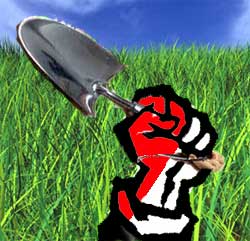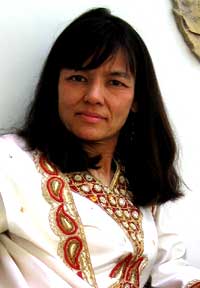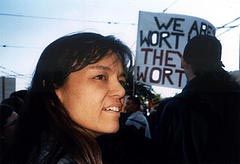|
from 28 august 2005 blue vol IV, #20 |
|

by Amanda Kovattana
 When I learned these salient facts, I couldn't look at a strawberry without thinking "you toxic, ozone depleting double agent - you were supposed to be good for us". Then I began to feel sorry for them being co-opted like that so I decided to grow them myself. There's nothing like high stakes to make one's gardening efforts worthwhile. Nurseries had just stocked up on six packs of them. I planted a dozen in a tower of three stacking pots. And while I was at it, I potted some up for my mother, too, in her strawberry planter. It was so easy I started to think of a list of people to whom I could spread this strawberry intervention. After all two weeks ago I had never heard of Methyl Bromide, so it was very likely still news to most of my friends.
When I learned these salient facts, I couldn't look at a strawberry without thinking "you toxic, ozone depleting double agent - you were supposed to be good for us". Then I began to feel sorry for them being co-opted like that so I decided to grow them myself. There's nothing like high stakes to make one's gardening efforts worthwhile. Nurseries had just stocked up on six packs of them. I planted a dozen in a tower of three stacking pots. And while I was at it, I potted some up for my mother, too, in her strawberry planter. It was so easy I started to think of a list of people to whom I could spread this strawberry intervention. After all two weeks ago I had never heard of Methyl Bromide, so it was very likely still news to most of my friends.
I never really understood why synthetic fertilizers were a problem either. If it helped plants grow what was the harm in that? That's how it's done with large-scale farming and how else were we to feed the growing population? To really understand what a complete and total disaster this chemical driven food system is, I had to learn more. Nitrogen in the natural world is made by plants that create nitrogen in the soil, which can then be used, by other plants. Synthetic nitrogen overwhelms the soil with this plant food, creating a population boom in nitrogen feeders. And while these feeders gorge themselves on nitrogen, the organic content of the soil - the humus - is burned up and the soil begins to collapse. This collapsed soil needs more water, which then washes away more nutrients and what's left of the beneficial microbial life clinging to the soil structure. The plant becomes more susceptible to pests and disease and continues to crave even more nitrogen. I've seen enough heroin addict movies to recognize a drug problem and this one is a doozie. While the reserve of humus was being burned up, the plant responded with tremendous yields. This was the unbelievable high that prompted agribusiness to become the biggest drug pushers in the global hood. According to a U.N. study the party ended in 1984. The U.S. and Mexico could no longer expect increased yields from synthetic fertilizers, while farmers were left with an expensive drug habit to support. Not to mention the cost of pesticides and herbicides and fumigants - think of it as the medical bill for the junkie. Then there's the algae bloom caused by run-off choking off oxygen in large parts of the Mississippi and the Gulf of Mexico that was the end of commercial fishing. Oh yes and the effect of nitrogen on us humans. Once nitrate is in the water supply and is ingested into our body, it combines with our blood, changing the structure and reducing its ability to hold oxygen. So our body breaks down just like the soil. I'm telling you, the earth is a living body and we're not going to get a technological cure any better than nuking cancer cells with radiation. As we pursue healthier eating and exercise in an attempt to stave off disease, it helps to think of the earth as part of our body too. During this intensive study, I happened to be at a meeting where I met a women who had me on her e-list for news about the Biointensive for Russia project, an offshoot of Ecology Action in Willits where I had taken my workshop in Biointensive farming. She slipped me a flyer for a tour of some very special gardens in Santa Cruz offering alternatives to our chemically driven food system. We went Saturday, a car-full of us. The first garden was at the home of Permaculture landscape designer Ken Foster. He had just won the Sunset Magazine award for his work with two others on their ecological garden exhibit at the garden show at the Cow Palace. I somehow had in my mind that he owned a palatial garden I would be hard put to replicate so I was quite surprised when we pulled up to a neighborhood of shabby tract homes on modest lots. It was immediately clear which house was his. The one without the lawn. The plot was spilling over with all kinds of plants bordered at the sidewalk with a living fence of espaliered dwarf apple trees. One of the trees sported six different varieties of apples grafted to the trunk. The fence demonstrates a principle of Permaculture - stacking functions - think of multi-use furniture. Here we had food, structural function and beauty all in one plant. I then spotted the mulch. Mulch is a lifesaver in California, keeping moisture in the soil so you don't have to water as much. I got on all fours to inspect what looked like shredded garden waste. I was bowled over by the potpourri of scents and the visual feast of seeds, herbs and woody bits. Ken explained that he collected this gourmet mulch from a local shop in Santa Cruz that served Chai Tea. And that must be all it serves because they were throwing out a dumpster load every week. Now Ken picks it up and uses it in his landscaping. He would sell it to us for $8 dollars a bag, $10 if delivered, thus fulfilling the internationally recognized Triple Bottom Line business model - ecological stewardship, social equity and economic viability. And cats don't like it, so they won't use your garden to poop in. The rest of his garden was a wonderland of Permaculture systems I had been studying, including rainwater harvesting, graywater reuse, egg laying chickens, exotic berry trees, worm bins and water fountains all in a space smaller than my own. He warned us that the backyard would be messy. A weed after all was part of the system, bringing up minerals from the soil that other plants can't reach. And there was a wild space in the corner to encourage the plant divas. No humans are allowed in this space. This was a symbolic gesture, Ken explained, of the intention to work with nature. More like this please. We then traveled up the hill to the campus of my youth, UCSC. Alan Chadwick, a Shakespearian actor turned gardener with his merry band of apprentices had created a garden here. None of my friends ever mentioned this garden. We were too busy being cool and gardens were just not cool unless you could smoke what you were growing or go there on an acid trip. It would be another five years before I took up gardening. Alan Chadwick was a visionary of the Biodynamic/French intensive school of farming. His vision lives on at the UCSC farm and project garden. All 25 acres of it. It is here that visitors can see organically grown pest free strawberries. And this is not just a hopeful suggestion; this is scientifically gathered information with measured yields and sophisticated techniques of plant husbandry and pest management all grown on a scale large enough to attract the attention of a commercial farmer. Bankers come here to learn how to cash in on the growing organic farm trend. (20-30% every year; see how powerful we consumers can be!) Five star chefs come to learn the origin of foods and to study what produces superb taste in fruits and vegetables. Then there are the apprentices, young and passionate, 40 of them twice a year, living on the farm for 6 months to soak up this goldmine of information. With our knowledgeable docent, we toured the farm and all its many gardens. The more diversity of plant life you have, the more help you get from nature. Help in the form of predators and pollinators. The irony of commercial farming is that, in its attempt to increase yields with chemicals, it poisoned the natural agents that insure the highest productivity of plants. In 1994 bees had to be trucked in from out-of- state to insure that California almond growers wouldn't lose their $800 million a year crop. And they continue to be trucked in creating a niche market for pollination contractors! The farm had nesting boxes for barn owls to keep the gophers at bay and bees for pollination as well as plants of all sorts to attract insects and birds. I learned how to stymie the coddling moth that ruin our crop of apples every year. It's done with pheromones. I learned how apple trees can be pruned so close to the ground you can pick apples without a ladder. This saves on workers comp! I learned how you can fumigate the soil naturally by growing mustard. You've heard of mustard gas, same thing. I learned that a moderately big compost pile will disappear a dead gopher in no time at all. When I die I want to be buried in a compost pile. No preservatives added please. They also have a children's garden camp. This delightful playground of colorful displays, mosaic stepping stones and heirloom chickens teaches children where the ingredients for pizza comes from and then they cook the pizza in a cob oven shaped like a frog. The whole scene made me so happy I wanted to roll on the ground like a pig in hay bedding. It is good to know where your food comes from, comforting to see that it is all a part of the ever-bountiful earth we walk on. If you would like to visit this farm, an invitation has been kindly extended to me to bring my own group.

|
|||
| BLUE is looking for short fiction, extracts of novels, poetry, lyrics, polemics, opinions, eyewitness accounts, reportage, features, information and arts in any form relating to eco cultural- social- spiritual issues, events and activites (creative and political). Send to Newsdesk. |
